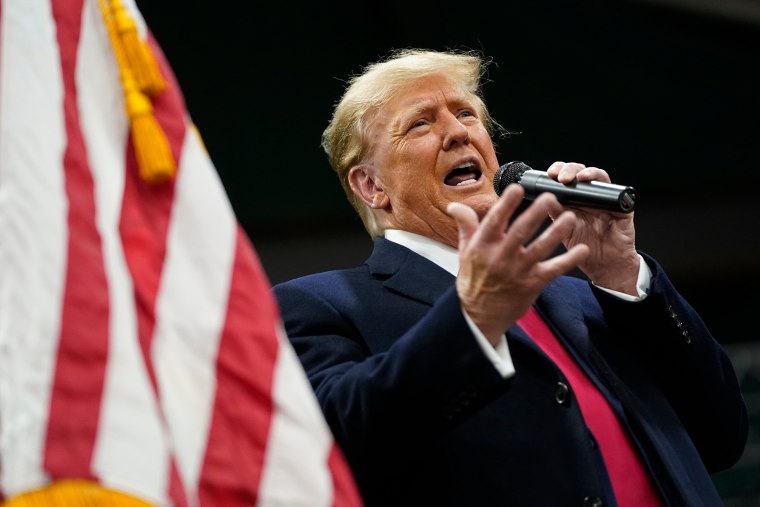Happening this Tuesday: Donald Trump easily wins Iowa caucuses, getting 51% of vote (with 99% in)…. Ron DeSantis finishes distant second at 21% to Nikki Haley’s 19%... Vivek Ramaswamy drops out after finishing fourth and endorses Trump… Trump attends E. Jean Carroll trial in New York and then campaigns in New Hampshire… And Haley also stumps in the Granite State, while DeSantis heads to South Carolina first before hitting New Hampshire.
But FIRST… Beyond former President Donald Trump’s 30-point victory in Iowa and beyond Ron DeSantis’ distant second-place finish was an even bigger story Monday night.
Donald Trump has transformed the Republican Party in his own image over the last eight years — from when he finished second in Iowa’s caucuses with 24% of the vote in 2016, to winning all but one Iowa county in 2024.
Just look at these numbers in the NBC News Iowa entrance poll:
- 56% of last night’s caucusgoers were men — up from 52% in 2016.
- 41% were 65 years old or older — up from 27% eight years ago.
- 52% said they were “very conservative” — up 12 percentage points from 2016.
- 55% identified as being white evangelical Christian — down from 62% in 2016.
- Oh, and 66% of Iowa caucusogers last night said they believed President Joe Biden did NOT legitimately win the 2020 election (when, in fact, he did).
Interestingly, one thing that stayed the same last night was the college vs. non-college GOP makeup in Iowa, with 51% saying they had college degrees versus 49% without — the exact same percentages from 2016.
But also check out this breakdown: Trump won 67% of non-college caucusgoers last night, versus 37% of college grads.
Bottom line: Last night’s GOP electorate in Iowa was older, more male, less evangelical, more conservative and willing to believe Trump’s mistruths about the 2020 election.
As NBC’s Chuck Todd observed, it was hard for DeSantis or other Republicans to run to Trump’s right, because the former president has defined what the right is.
Headline of the day
The number of the day is … 3
That’s the number of major candidates for the GOP presidential primary left after Iowa’s caucuses on Monday night — Trump, Haley and DeSantis.
Entrepreneur Vivek Ramaswamy dropped out of the race and endorsed Trump after coming fourth in the caucus on Monday, NBC News’ Katherine Koretski reports.
Meanwhile, Trump, DeSantis and Haley each picked up delegates, inching their way toward the Republican National Convention this summer. Trump left Iowa with 20 delegates, DeSantis picked up eight and Haley nabbed seven.
Now, the spotlight shifts to New Hampshire, with the state’s first-in-the-nation primary in just one week. Trump’s team is gearing up to more aggressively target Haley in New Hampshire, and she’s looking to do the same, NBC’s Natasha Korecki, Matt Dixon and Jane C. Timm report.
Meanwhile, on the Democratic side, New Hampshire’s primary is a wash, since the state did not comply with the Democratic National Committee’s new calendar. Biden isn’t on the ballot as a result, but some Democrats have still launched a “weird” write-in campaign, per NBC’s Alex Seitz-Wald.
Eyes on November: Results in the five key Iowa counties
On Monday we laid out five key counties to watch in Iowa for clues about the first GOP contest. Well, Trump ended up winning 98 of Iowa’s 99 counties, except for Johnson County, where Haley holds a one-vote lead, per the NBC News Decision Desk.
But underneath the surface, the margins help explain Trump’s decisive win in Iowa, and how DeSantis grabbed second place.
Here’s what happened in those five key counties:
Buena Vista County: Trump overwhelmingly carried this rural county in northwest Iowa, which is nearly 30% Latino, winning 62% of the vote while Haley and DeSantis each won 15%. DeSantis’ inability to run up his margins in a county Texas GOP Sen. Ted Cruz won in 2016 helps explain why he came in such a close second-place finish to Haley’s third place.
Linn County: Haley barely edged out DeSantis for second place in this eastern county, which includes the city of Cedar Rapids and its surrounding suburbs, winning 25% of the vote to DeSantis’ 24%, while Trump won 43%. That shows Trump underperforming compared to his statewide total, but his ability to win even suburban areas where he is less popular helps explain his wide statewide margin.
Polk County: The results in Polk County, the most populous in the state and includes Des Moines, help explain why Haley couldn’t overtake DeSantis for second place statewide. Polk was one of five counties Florida GOP Sen. Marco Rubio won in 2016, and the kind of higher-educated, suburban area where Haley’s campaign was looking to do well. But she came in third, with Trump winning 38% of the vote, while DeSantis won 27% and Haley won 26%.
Scott County: This eastern county, which includes Davenport, was another one to watch for whether Trump’s margin could be dragged down by anti-Trump voters in the suburbs. But that wasn’t the case. He won 49% of the vote here, similar to his share statewide, while DeSantis won 27% and Haley won 26%.
Sioux County: The results in this county in northwest Iowa also help explain how DeSantis was able to hold onto a second-place finish. He overperformed in this county, which is home to many evangelical voters, winning 31% of the vote while Haley won 26%. But Trump’s 45% vote share was still difficult to overcome, underscoring how Trump has solidified his support among evangelicals and Republicans in rural areas (he won just 11% of the vote there back in 2016.)
ICYMI: What ELSE is happening in the world
Defense Secretary Lloyd Austin was released from the hospital Monday after he was hospitalized for more than two weeks following complications from surgery to treat prostate cancer.
In an apparent “swatting” incident, a person called 911 on Monday falsely reporting a fire at the White House.



